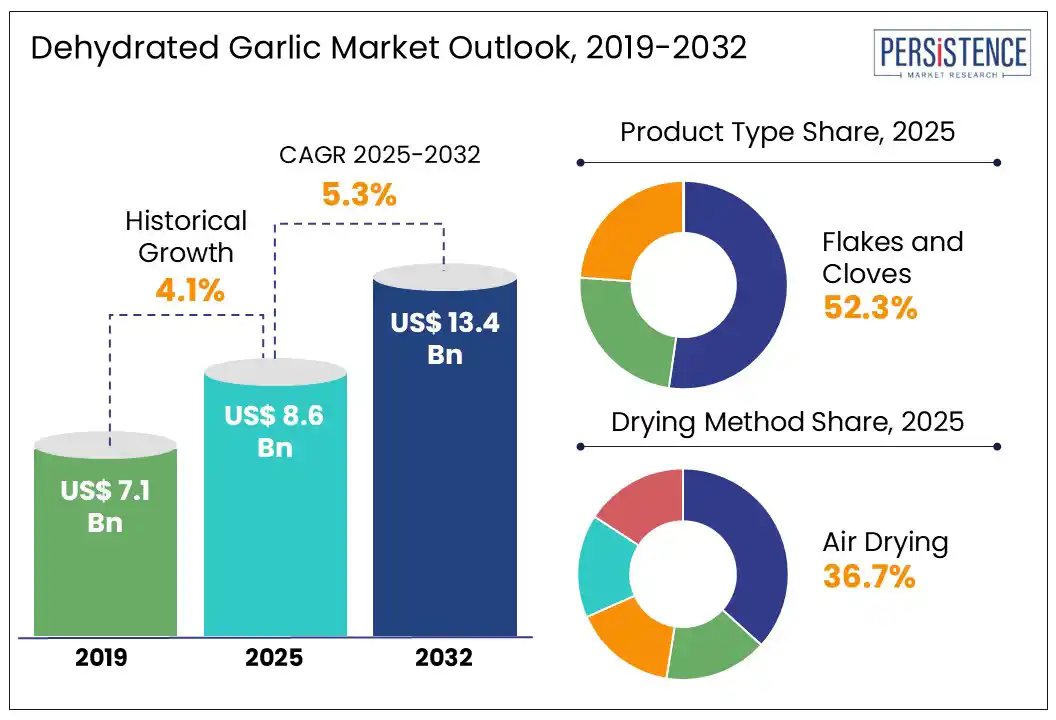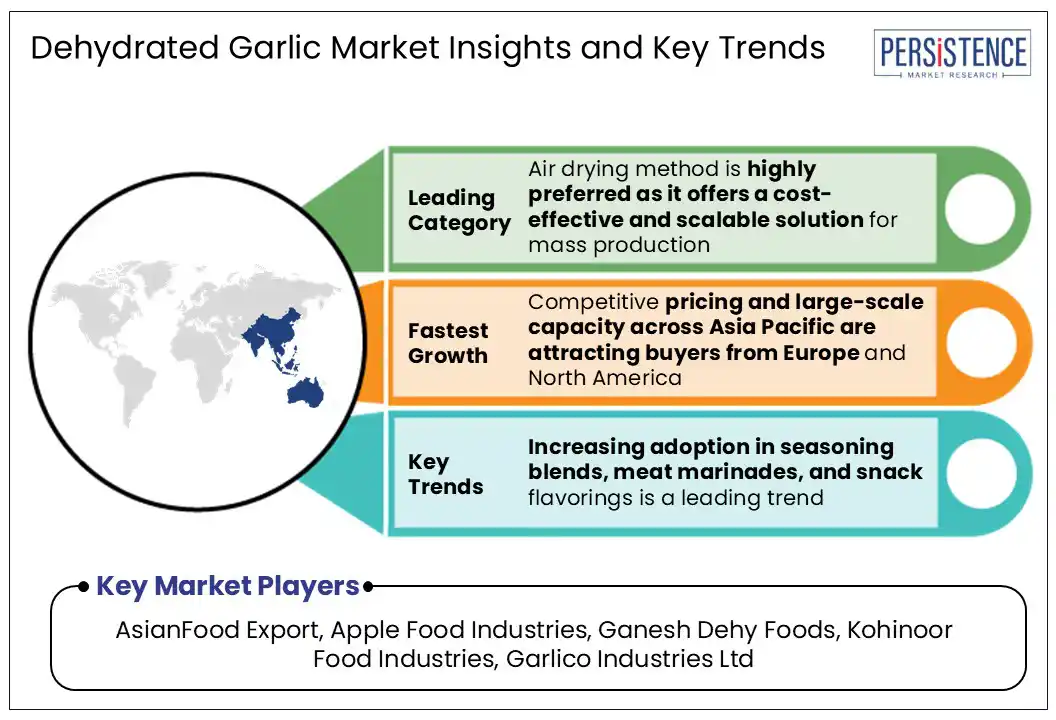ID: PMRREP35494| 198 Pages | 17 Jul 2025 | Format: PDF, Excel, PPT* | Food and Beverages

The dehydrated garlic market size is likely to be valued at US$8.6 Bn in 2025 and is estimated to reach US$13.4 Bn in 2032, growing at a CAGR of 5.3% during the forecast period 2025-2032.
Dehydrated garlic has emerged as a significant ingredient in global food processing industry. This is attributed to its extended shelf life, versatility, and consistent quality. As fresh garlic is highly perishable and logistically demanding, dehydration offers a commercially viable alternative without compromising core flavor or nutritional value. The market is seeing steady growth with rising demand from processed food sectors, functional food producers, and nutraceutical manufacturers seeking shelf-stable ingredients. With evolving drying technologies, dehydrated garlic, including garlic salt, is transitioning from a commodity ingredient to a key component in diversified product portfolios.

Key Industry Highlights
|
Global Market Attribute |
Key Insights |
|
Dehydrated Garlic Market Size (2025E) |
US$ 8.6 Bn |
|
Market Value Forecast (2032F) |
US$ 13.4 Bn |
|
Projected Growth (CAGR 2025 to 2032) |
5.3% |
|
Historical Market Growth (CAGR 2019 to 2024) |
4.1% |
The nutritional retention of dehydrated garlic, mainly the preservation of allicin, manganese, vitamin B6, selenium, and antioxidants, is influencing demand. While dehydration reduces moisture content, studies show that various bioactive components in garlic remain intact when processed correctly. For example, a 2023 study published in the Foods journal confirmed that freeze-dried and air-dried garlic retained over 70% of their total phenolic and antioxidant activity. This makes them suitable for nutraceutical and fortified food applications.
The nutritional stability has further fostered its use in the dietary supplement industry. In this industry, dehydrated garlic is often used in tablet, capsule, and powder formulations aimed at cardiovascular health, immune support, and cholesterol regulation. Leading supplement brands are capitalizing on this trend by marketing odorless garlic capsules derived from dehydrated sources that maintain high allicin content without the pungent flavor of fresh garlic.
Despite their surging popularity, dehydrated garlic extracts face specific sensory-related challenges that are impeding their wide adoption. When garlic is dehydrated, primarily through high-heat methods such as hot-air drying, it undergoes Maillard reactions and sulfur compound degradation. This often results in a bitter aftertaste and a less pronounced aroma compared to fresh garlic. It has led to reluctance among chefs, artisanal food brands, and premium foodservice providers to fully transition to dehydrated variants.
The issue is particularly significant in Japan and Europe, where subtle flavor profiles and ingredient integrity are important to consumer acceptance. Another drawback is the inconsistent rehydration behavior of low-grade dehydrated garlic products. It further contributes to uneven flavor dispersion and perceived bitterness in final preparations. In bulk foodservice operations, these inconsistencies affect product standardization, making dehydrated garlic less reliable than fresh or paste forms.
The emergence of Fluidized Bed Drying (FBD) technology is creating significant opportunities for dehydrated garlic market growth. It is offering superior control over moisture removal, minimizing thermal degradation, and improving product uniformity. FBD enables rapid and consistent dehydration at lower temperatures, preserving volatile sulfur compounds that are significant for garlic’s aroma and health benefits. This has made the technology increasingly attractive for producers aiming to serve premium segments or health-focused applications.
One of the key advantages of FBD is its scalability and energy efficiency. A 2023 study published in the Journal of Food Engineering demonstrated that garlic processed using FBD retained nearly 85% of its antioxidant activity, compared to 65% in conventional tray drying. The same study reported an average energy savings of 25% per kilogram of output, making the method not just technologically superior but also commercially viable for medium- to large-scale processors. This has led to rising adoption in China and India, where manufacturers are upgrading to FBD systems to meet export quality benchmarks for Europe and North America.
By product type, the dehydrated garlic market is trifurcated into granules and powder, flakes and cloves, and chopped and minced. Among these, flakes and cloves are expected to hold around 52.3% share in 2025 as these offer superior rehydration characteristics and retain more of the original flavor and texture compared to powders or granules. These often undergo gentle drying, which helps preserve allicin and sulfur compounds that give garlic its pungency and therapeutic value. This makes them ideal for sauces, soups, and ready meals where the authenticity of flavor is paramount.
Dehydrated garlic granules and powder are gaining traction due to their operational efficiency, longer shelf stability, and compatibility with large-scale automated food production systems. These are ideal for dry seasoning mixes, spice blends, snack coatings, and instant food formulations where uniform dispersion is significant. These also allow for better control over particle size and flavor intensity in high-speed manufacturing lines. Hence, granules and powder are considered a suitable choice for mass-market processed food.
Based on drying method, the market is segregated into air, spray, freeze, drum, and vacuum drying. Air drying is poised to account for nearly 36.7% share in 2025, owing to its cost-effectiveness and ability to retain essential compounds when properly controlled. Its adaptability to different garlic forms, including slices, flakes, granules, and even crushed cloves, enables manufacturers to produce a range of textures with a single processing line. This versatility is important for B2B clients in the seasoning, snack, and meat processing industries who require different grades of garlic inputs.
Freeze drying is gaining momentum, backed by its ability to preserve the sensory and nutritional integrity of garlic, mainly in high-value applications. It involves sublimating moisture at low temperatures under vacuum conditions, which minimizes structural and chemical degradation. This helps retain volatile sulfur compounds responsible for garlic’s flavor and health benefits as well as its natural color, aroma, and texture. It offers superior rehydration, instantly restoring the texture and the flavor of fresh garlic when added to liquids.

In North America, dehydrated garlic is firmly ingrained in both industrial supply chains and household kitchens, supported by shifting consumer preferences. The U.S. dehydrated garlic market is expected to remain at the forefront as it imports over 100,000 MT of garlic annually. Companies in the country are adopting microwave-assisted, vacuum, freeze, and hybrid drying methods to preserve flavors, reduce energy usage, and ensure uniform quality. Product innovation is strong in organic, non-GMO, roasted, and single-origin varieties.
Regionally, supply in Canada remains heavily import dependent as more than 99% of garlic is sourced from China during winter months. High dependency on imported raw garlic exposes local processors to price or spoilage volatility and supply chain disruptions. This is spurring interest in domestic small scale and organic production. Buyers are also increasingly demanding organic, clean-label, and traceable sourcing, pressuring processors to absorb vertical integration costs.
Europe imports nearly 120 kilotons of dehydrated garlic annually, with only a small fraction sourced from its fresh production. Germany and the Netherlands serve as primary gateways, importing around 28 kilotons and 17 kilotons, respectively. At the consumer level, Europe is propelled by rising demand for natural, plant-based, and convenience products. Surging vegan or plant-based food consumption has significantly augmented use of garlic in meat substitutes and seasoning blends.
Artisanal and organic ranges are trending upward, helped by niche brands packaging imported bulk garlic into premium consumer goods. However, quality, traceability, and food safety compliance remain ongoing concerns in Europe. While China’s volumes suit low-cost segments, mistrust over sourcing and residue controls is pushing manufacturers toward suppliers offering transparent supply chains. This is anticipated to create new opportunities for niche, certified imports.
Asia Pacific is estimated to account for approximately 40.3% of the dehydrated garlic market share in 2025, owing to high garlic production volumes, especially in China and India. Increasing demand from food processing industries is also anticipated to boost growth. China alone produces more than 23 million tons of garlic annually, making it the most prominent source of raw material for dehydrated garlic production. India follows with around 5% of global production and is emerging as a strong player in exports, supported by modernized facilities.
India is becoming increasingly competitive with China in the export market. Domestic manufacturers such as Garlico Industries have invested in GMP-certified processing units. They are also focusing on residue-free garlic products to meet EU and U.S. import regulations. At the same time, they are introducing value-added products such as roasted garlic powder, organic garlic flakes, and seasoning blends targeting both retail and food service sectors. Thailand and South Korea are focusing on niche exports of high-flavor dehydrated garlic products used in gourmet cooking.
The dehydrated garlic market is characterized by regional dominance, fluctuations in prices, and a surging emphasis on quality certifications. China is at the forefront of growth, with leading players leveraging low labor costs and economies of scale to maintain price competitiveness. Their dominance, however, is being increasingly challenged by India-based suppliers. They are focusing on process modernization and compliance with stringent EU and U.S. food safety norms to extend their global footprint. There is also a notable shift toward integrated supply chains, where players are investing directly in garlic cultivation to reduce dependency on third-party growers.
The dehydrated garlic market is projected to reach US$ 8.6 Bn in 2025.
Rising institutional demand for bulk garlic formats and long shelf life of dehydrated garlic are the key market drivers.
The dehydrated garlic market is poised to witness a CAGR of 5.3% from 2025 to 2032.
The development of customized particle sizes and investments in solar-assisted drying methods are the key market opportunities.
AsianFood Export, Apple Food Industries, and Ganesh Dehy Foods are a few key market players.
|
Report Attribute |
Details |
|
Historical Data/Actuals |
2019 - 2024 |
|
Forecast Period |
2025 - 2032 |
|
Market Analysis Units |
Value: US$ Bn/Mn, Volume: As Applicable |
|
Geographical Coverage |
|
|
Segmental Coverage |
|
|
Competitive Analysis |
|
|
Report Highlights |
|
|
Customization and Pricing |
Available upon request |
By Product Type
By Drying Method
By Application
By Distribution Channel
By Region
Delivery Timelines
For more information on this report and its delivery timelines please get in touch with our sales team.
About Author